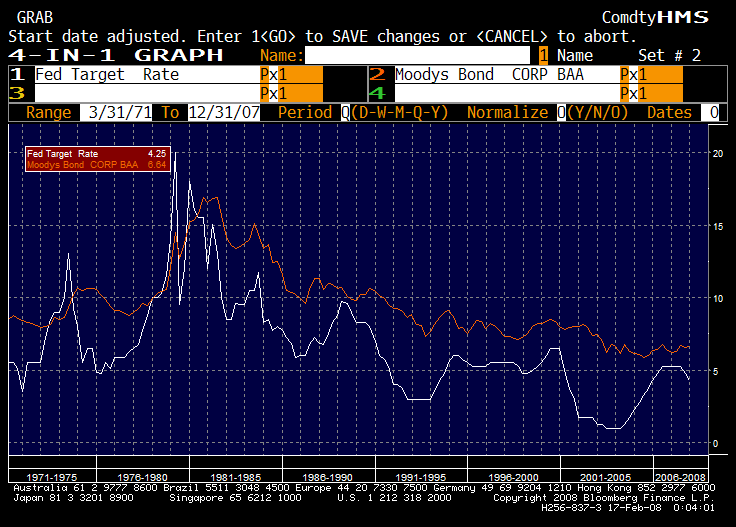In Some Ways, The Municipal Bond Market Was Asking For It
What do municipalities want from their bond market? Low long-term financing rates. In and of itself, that’s not a bad goal to pursue. The question is how you do it.
What prompted this post was an article from The Bond Buyer (via Google cache). The need for short-dated tax-free muni bonds drives hedge funds (typically) to buy long munis and sell short term debt to finance the bonds, which tax-free money market funds buy. For more on Variable Rate Demand Structures, look here. (Thanks, Accrued Interest. The article was prescient to the current troubles.) The Wall Street Journal also anticipated the current troubles in this article. The hedge funds could only take the pain for so long. As perceived risks rose with the sagging prospects of the financial guarantors, fewer market players wanted to buy the short term debt, because the collateral underlying the short term debt no long had high enough ratings. That led to the hedge funds having to collapse their balance sheets, selling the long munis, and repaying the short term debts, taking losses in the process.
Now, many of the same difficulties apply to auction rate bonds (another article from Accrued Interest), no matter who the obligor (entity that must pay on the bond) is. As I commented recently:
Part of the difficulty here is that auction rate structures are unstable. They can handle 30 mph winds, but not 60 mph winds. Auction rate structures deliver low rates when things are calm, but can be toxic when short term liquidity dries up. A sophisticated borrower like the NY Port Authority should have known that going in. Small borrowers are another matter, their investment banks should have explained the risks.
Yes, the explanations are all there in the documents, but a good advisor explains things in layman?s terms. That said, it is usually the shortsightedness of local governments wanting low rates and long term funding at the same time that really causes this. You can have one or the other, but not both with certainty.
Or, as I commented at RealMoney:
| David Merkel | ||
| Failed Muni Auctions are not the End of the World | ||
| 2/14/2008 2:50 PM EST |
Most of the municipalities with the failed auctions are creditworthy entities that don’t need bond insurance. Bond insurance is “thought insurance.” The bond manager doesn’t have to think about the credit if he knows the guarantor is good. If the guarantor is not good, then the bond manager has to get an analyst to look at the underlying creditor. That takes work and thought, and both of those hurt. Daniel Dicker is on the right track when he says the municipalities are racing refinance. Well, good. Auction rate structures are stable under most conditions, but under moderate stress, like the lack of confidence in the guarantor, they break. I would like to add, though that auction rate structures are kind of a cheat. Why?
1) The municipality gets to finance short, which usually reduces interest costs, but loses the guarantee of fixed-rate finance. 2) This is driven by investors who want tax-free money market funds. Most municipalities don’t want to issue the equivalent of commercial paper. They want long term financing. 3) The auction rate structure seems to give the best of both worlds: long term financing at short rates, without having to formally issue a floater. 4) For minor hiccups, an interested investment bank might take down bonds, but in a crisis, they run faster than the other parties from a failed auction.
The municipalities could have issued fixed or floating-rate debt over the same term, but they didn’t because it was more expensive. Well, now they will have to bear that expense, and yes, as Daniel points out, that will make the muni yield curve steepen.
Pain to municipalities, which will mean higher taxes for debt service. Fewer auction rate securities to tax free money market funds. It’s a crisis, but not a big crisis.
Position: none
Let me put it another way. No one complained when hedge funds levered up the long end of the muni market, allowing municipalities to finance more cheaply than they should have been able to. But now that the leverage is collapsing, and municipalities that did not prudently lock in their rates, but speculated on short rates are getting hurt, should it be a major crisis? I think not. Personally, I think the wave of auction failures will give way to refinancing long, and a new group of speculators buying auction rate securities at higher yields than the prior short-term equilibrium yield.


